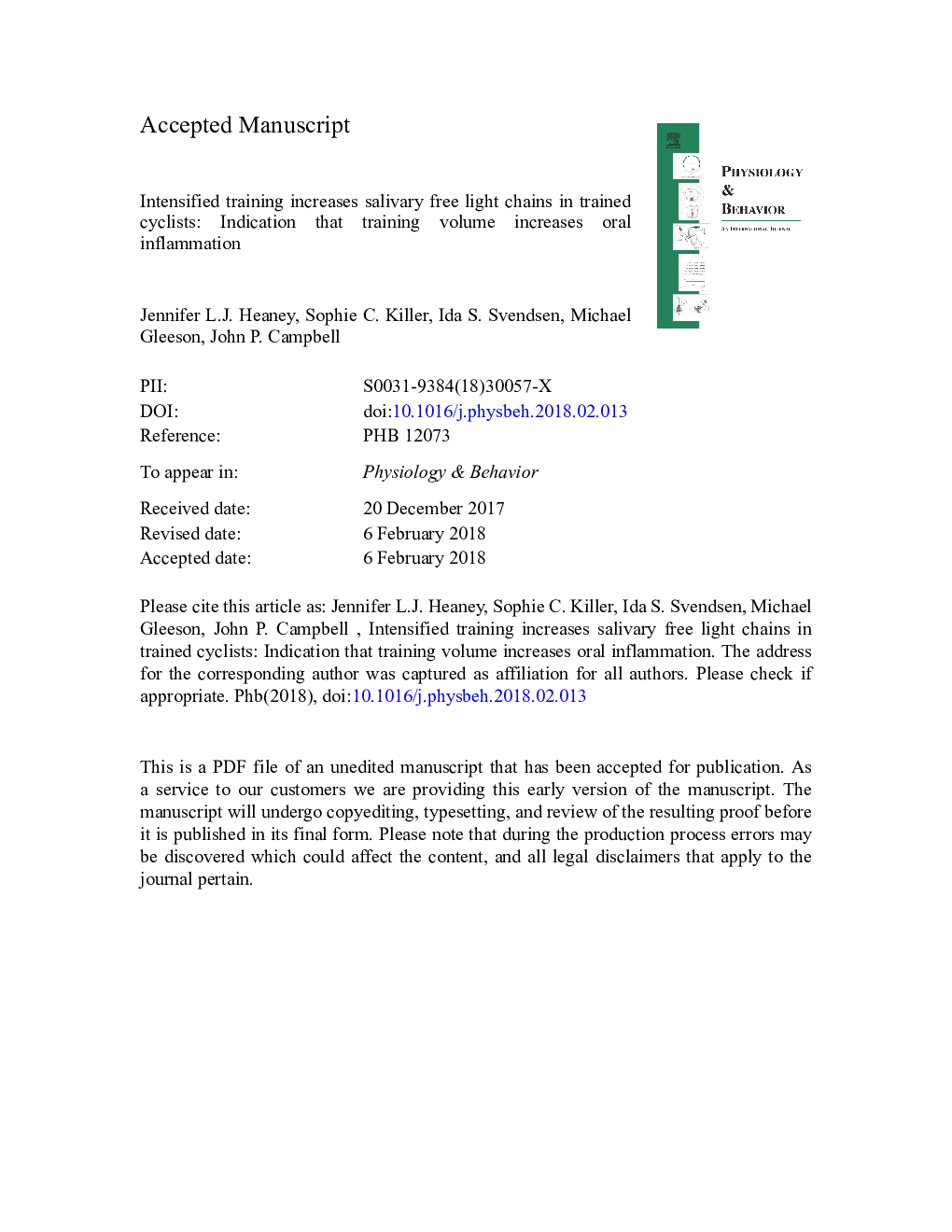| کد مقاله | کد نشریه | سال انتشار | مقاله انگلیسی | نسخه تمام متن |
|---|---|---|---|---|
| 8650586 | 1571131 | 2018 | 26 صفحه PDF | دانلود رایگان |
عنوان انگلیسی مقاله ISI
Intensified training increases salivary free light chains in trained cyclists: Indication that training volume increases oral inflammation
ترجمه فارسی عنوان
تمرینات شدید باعث افزایش زنجیرهای سبک آزاد بزاق در دوچرخهسواران آموزش دیده می شود: نشان می دهد که میزان تمرین افزایش التهاب دهان
دانلود مقاله + سفارش ترجمه
دانلود مقاله ISI انگلیسی
رایگان برای ایرانیان
کلمات کلیدی
زنجیرهای رایگان بزاق، ورزش، آموزش، ورزشکاران، التهاب
موضوعات مرتبط
علوم زیستی و بیوفناوری
بیوشیمی، ژنتیک و زیست شناسی مولکولی
فیزیولوژی
چکیده انگلیسی
Periods of short-term intensified training (IT) are often used by athletes during training cycles over the season and undergoing phases of increased physical stress may impact upon the immune system. This study investigated the effects of a period of IT on free light chains (FLCs) in saliva - an emerging immune biomarker of oral inflammation - and matched serum samples in well-trained athletes. It also examined if IT influences basal FLC levels and FLC flux during acute exercise. Highly trained male cyclists (nâ¯=â¯10) underwent a 9-day period of IT; before and after IT participants performed a 1â¯h time trial (TT) on a cycle ergometer, with blood and saliva samples collected pre- and post-exercise. FLCs were assessed in serum and saliva, and IgG, IgA, IgM and creatinine were also measured in serum. Weekly training volume increased by 143% (95% CI 114-172%), pâ¯<â¯0.001, during IT compared with pre-trial baseline training. Following IT, the cyclists demonstrated higher salivary FLC levels. Both salivary lambda FLC concentrations (pâ¯<â¯0.05, η2â¯=â¯0.384) and secretion rates, and kappa FLC concentrations and secretion rates increased after IT. Salivary FLCs concentration and secretion rates decreased in response to the TT following IT (pâ¯<â¯0.05, η2â¯=â¯0.387-0.428), but not in response to the TT prior to IT. No significant effects of IT on serum FLCs were observed. There were no significant changes in serum FLCs in response to the TT, before or after the IT period, nor did IT impact upon other serological responses to the TT. In conclusion, IT increased basal salivary FLC parameters and amplified decreases in salivary FLCs in response to acute exercise. Increases in salivary FLC concentration likely reflects alterations to oral inflammation during times of heavy training, and we show for the first time that FLCs may have utility as a marker of exercise stress and oral health status.
ناشر
Database: Elsevier - ScienceDirect (ساینس دایرکت)
Journal: Physiology & Behavior - Volume 188, 1 May 2018, Pages 181-187
Journal: Physiology & Behavior - Volume 188, 1 May 2018, Pages 181-187
نویسندگان
Jennifer L.J. Heaney, Sophie C. Killer, Ida S. Svendsen, Michael Gleeson, John P. Campbell,
